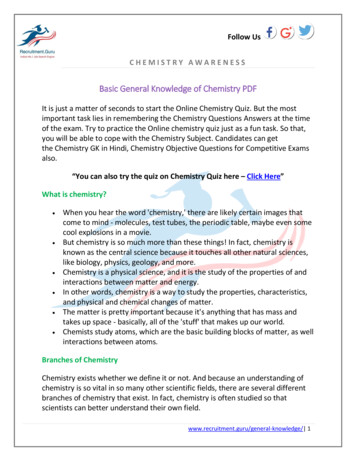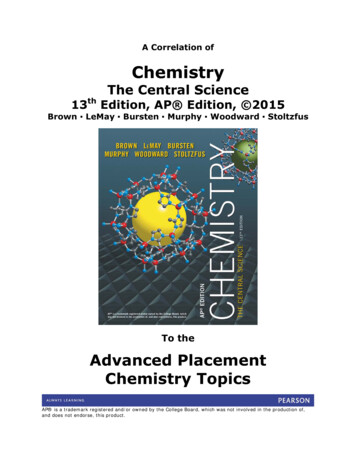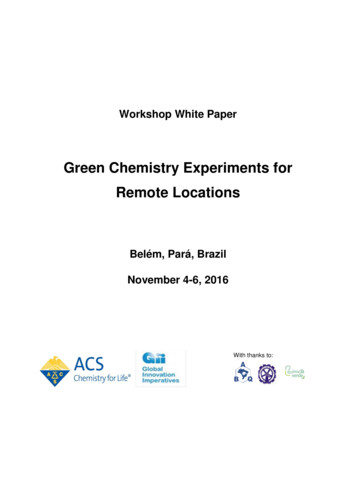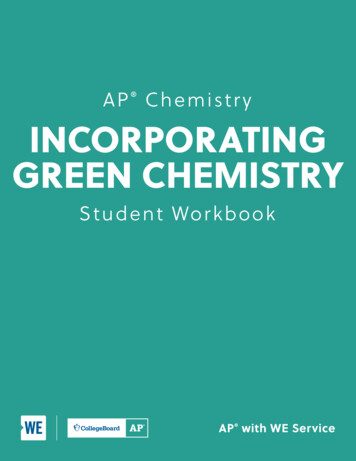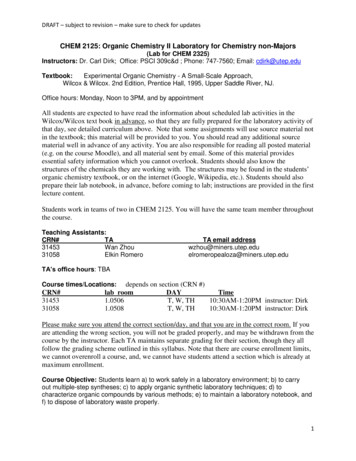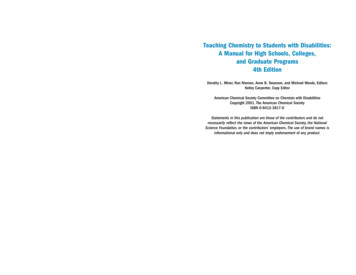
Transcription
Teaching Chemistry to Students with Disabilities:A Manual for High Schools, Colleges,and Graduate Programs4th EditionDorothy L. Miner, Ron Nieman, Anne B. Swanson, and Michael Woods, EditorsKelley Carpenter, Copy EditorAmerican Chemical Society Committee on Chemists with DisabilitiesCopyright 2001, The American Chemical SocietyISBN 0-8412-3817-0Statements in this publication are those of the contributors and do notnecessarily reflect the views of the American Chemical Society, the NationalScience Foundation, or the contributors’ employers. The use of brand names isinformational only and does not imply endorsement of any product.
Table of ContentsIntroduction . . . . . . . . . . . . . . . . . . . . . . . . . . . . . . . . . . . . 4Chapter 1. Disability Laws and Services . . . . . . . . . . . . . . . .10Rehabilitation Act of 1973 . . . . . . . . . . . . . . . . . . . . . . . . . . . . .11Individuals with Disabilities Education Act . . . . . . . . . . . . . . . .12Americans with Disabilities Act of 1990 . . . . . . . . . . . . . . . . . .14Institutional and faculty obligations . . . . . . . . . . . . . . . . . . . . . .14Disability services for students . . . . . . . . . . . . . . . . . . . . . . . . . .15Focus on full participation . . . . . . . . . . . . . . . . . . . . . . . . . . . . .16Faculty responsibilities . . . . . . . . . . . . . . . . . . . . . . . . . . . . . . . .17DSS assistance with accommodations . . . . . . . . . . . . . . . . . . . . .18Chapter 2. In the Classroom . . . . . . . . . . . . . . . . . . . . . . . . .21Presemester planning . . . . . . . . . . . . . . . . . . . . . . . . . . . . . . . . .21During the semester . . . . . . . . . . . . . . . . . . . . . . . . . . . . . . . . . .23Taking notes . . . . . . . . . . . . . . . . . . . . . . . . . . . . . . . . . . . . . . . .25Students with limited mobility . . . . . . . . . . . . . . . . . . . . . . . . . .26Students who are blind or vision-impaired . . . . . . . . . . . . . . . . .26Students who are deaf or hearing-impaired . . . . . . . . . . . . . . . . .31Students with learning disabilities or ADHD . . . . . . . . . . . . . . .34Other disabilities and individual accommodations . . . . . . . . . . .42Chapter 3. Testing and Evaluation . . . . . . . . . . . . . . . . . . . .43Past accommodations as a guide . . . . . . . . . . . . . . . . . . . . . . . . .43Students with limited mobility . . . . . . . . . . . . . . . . . . . . . . . . . .45Students who are blind or vision-impaired . . . . . . . . . . . . . . . . .46Students who are deaf or hearing-impaired . . . . . . . . . . . . . . . . .46Students with learning disabilities or ADHD . . . . . . . . . . . . . . .47Chapter 4. Assistive Technology and Accessible Computing . .48Benefits of computer technology . . . . . . . . . . . . . . . . . . . . . . . .48Students with limited mobility . . . . . . . . . . . . . . . . . . . . . . . . . .49Students who are blind or vision-impaired . . . . . . . . . . . . . . . . .53Students who are deaf or hearing-impaired . . . . . . . . . . . . . . . . .55Students with learning disabilities or ADHD . . . . . . . . . . . . . . . .56 2Chapter 5. In the Laboratory . . . . . . . . . . . . . . . . . . . . . . . .59General laboratory considerations . . . . . . . . . . . . . . . . . . . . . . .59Architectural modifications . . . . . . . . . . . . . . . . . . . . . . . . . . . .60Directed laboratory assistants . . . . . . . . . . . . . . . . . . . . . . . . . . .62Students with limited mobility . . . . . . . . . . . . . . . . . . . . . . . . . .62Students who are blind or vision-impaired . . . . . . . . . . . . . . . . .68Students who are deaf or hearing-impaired . . . . . . . . . . . . . . . . .71Students with learning disabilities or ADHD . . . . . . . . . . . . . . .72Chapter 6. Mentoring and Advocacy: Ensuring SuccessfulTransitions to Higher Education and Employment . . . . . . . . . .73Proving abilities . . . . . . . . . . . . . . . . . . . . . . . . . . . . . . . . . . . . .73Mentoring students with disabilities . . . . . . . . . . . . . . . . . . . . . .74High school . . . . . . . . . . . . . . . . . . . . . . . . . . . . . . . . . . . . . . . .75Participation, avoiding gaps . . . . . . . . . . . . . . . . . . . . . . . . . . . .76High school to college . . . . . . . . . . . . . . . . . . . . . . . . . . . . . . . .77Acquiring skills . . . . . . . . . . . . . . . . . . . . . . . . . . . . . . . . . . . . .78College . . . . . . . . . . . . . . . . . . . . . . . . . . . . . . . . . . . . . . . . . . .79The DSS office . . . . . . . . . . . . . . . . . . . . . . . . . . . . . . . . . . . . .81Resolving problems . . . . . . . . . . . . . . . . . . . . . . . . . . . . . . . . . .82College to graduate school, postdoctoral service,and employment . . . . . . . . . . . . . . . . . . . . . . . . . . . . . . . . . . . . .83Employment . . . . . . . . . . . . . . . . . . . . . . . . . . . . . . . . . . . . . . .84Chapter 7. Universal Design: Accessibility for Everyone . . . . .86Classrooms and laboratories . . . . . . . . . . . . . . . . . . . . . . . . . . . .86User-friendly emphasis . . . . . . . . . . . . . . . . . . . . . . . . . . . . . . .87Universal design for the lab . . . . . . . . . . . . . . . . . . . . . . . . . . . .88On the Internet . . . . . . . . . . . . . . . . . . . . . . . . . . . . . . . . . . . . . .89Why do it? . . . . . . . . . . . . . . . . . . . . . . . . . . . . . . . . . . . . . . . . .90Accessibility guidelines . . . . . . . . . . . . . . . . . . . . . . . . . . . . . . .91Accessibility needs for specific disabilities . . . . . . . . . . . . . . . . .94Conclusion: A great adventure for all . . . . . . . . . . . . . . . . . . . . .96Resources . . . . . . . . . . . . . . . . . . . . . . . . . . . . . . . . . . . . . .97References . . . . . . . . . . . . . . . . . . . . . . . . . . . . . . . . . . . .139Credits . . . . . . . . . . . . . . . . . . . . . . . . . . . . . . . . . . . . . . .146Disclaimer . . . . . . . . . . . . . . . . . . . . . . . . . . . . . . . . . . . .1473
Introduction 4Individuals with physical disabilities often encounter barriers toone of modern society’s most important rites of passage. It is thatcrucial process of obtaining a good education—so natural anduncomplicated for most people—that opens the door to productiveemployment and full participation in society. Today’s barriers arerarely physical or architectural. More often, they involve perceptions and misperceptions of not just disability but also ability. Onemisperception is that a physical disability somehow disqualifies aperson from a career in science, engineering, or mathematics. Wellintentioned but misinformed adults still discourage students withdisabilities from pursuing careers in these fields. Often it occursindirectly and implicitly, when adults withhold the mentoring andencouragement that can nudge young people toward sciencecareers and sustain their interest. In addition, adults may set artificial limits on what the student with disabilities should attempt.These limits may be based not on reality but on the adults’ ownlow expectations for the student or sincere concerns that the student may fail and not cope well with failure. In reality, studentswith disabilities benefit from the freedom to establish their ownhorizons (1), cope very well with the process, and learn from it.Study after study verifies the result of this lack of encouragement. Despite many advances and individual success stories, people with physical disabilities are underrepresented in sciencecareers. They constitute about 10.4% of the overall workforce butonly 2.7% of the science and engineering workforce, according toU.S. Census figures. This disparity does not reflect a lack of interest in science. A study by the American Council on Education(ACE), for example, revealed that college freshmen with disabilities express just as much interest in pursuing a science major astheir peers (2). This interest, unfortunately, seldom translates into acareer in science. The loss of this talent in the sciences is substantial. ACE found that about 9.4% of all 1998 college freshmen—more than 150,000 students—reported a disability (2). Yet,National Science Foundation (NSF) data suggest that fewer than320 individuals with disabilities received doctorates in science orengineering in 1997 (3) (7% of all 1988 freshmen reported a disability). Overall, individuals with disabilities remain the mostunderemployed and unemployed group in society.The American Chemical Society (ACS) has pioneered efforts toremove barriers that hamper individuals with disabilities fromstudying chemistry and starting careers in science. ACS, theworld’s largest scientific organization, focuses its efforts throughits Committee on Chemists with Disabilities (CWD). The commit-tee’s projects include three previous editions of this book, whichwere entitled Teaching Chemistry to Students with Disabilities.This fourth edition, renamed Teaching Chemistry to Students withDisabilities: A Manual for High Schools, Colleges, and GraduatePrograms, shares a similar concern and commitment. A companionpublication, Working Chemists with Disabilities (4), describes howscientists maintain productive careers in research, teaching, andother fields despite physical disabilities. NSF generously fundedwork on Teaching Chemistry.Practical information for classroom and labTeaching Chemistry is a resource book for teachers at the highschool, college, and postgraduate levels; students with disabilities;parents; counselors; and professional staff in college DisabilityServices for Students (DSS) Offices. Since publication of the initialedition in 1981, Teaching Chemistry has become a standard reference on the topic. ACS has distributed thousands of copies of thefirst three editions of Teaching Chemistry without charge in theUnited States and other countries. Teaching Chemistry is widelyrecognized as a source of practical information about how to promote full participation of students with disabilities in the classroom5
and laboratory. Prepared by scientists who themselves haveexcelled in chemistry despite physical disabilities and experts ondisability issues, the book is noted for its sensitivity to the underlying desires of almost every student with a physical disability. Oneof these is to be judged by one’s performance and academicachievement and not by one’s disability. Another is to make theirown decisions on what challenges to undertake. Yet another is toplay a major role in selecting the approaches and accommodationsneeded to meet challenges.Students with disabilities have individual needs, just like theirable-bodied classmates. Those needs depend on the specific disability. All students, however, learn best when teachers addressindividual needs. Teaching Chemistry provides information about avariety of successful classroom and laboratory accommodations forstudents with disabilities. In many instances, the accommodationsare simple, inexpensive, and require little significant change ininstructional approach or additional effort from the instructor.It’s the right thing to do 6Why should an instructor exert that extra effort, no matter howsmall? There are two compelling reasons.Instructors should provide accommodations because it is the rightthing to do, and Teaching Chemistry embraces this as its centraltheme. Society cannot afford to limit science careers to certaingroups in the population: only people with perfect eyesight or hearing, the strong, the fleet of foot. Rarely, if ever, is great physicalprowess a prerequisite for a successful career in science. Thatmakes science, engineering, and mathematics ideal career optionsfor individuals with disabilities. Excluding people from science onthe basis of physical attributes would be a terrible waste of humantalent and diversity.A diverse scientific workforce is increasingly recognized asessential to ensure our country’s competitiveness in the high-techglobal marketplace (3). Indeed, diversity has become an axiom insome sectors of the economy, including the global biopharmaceutical industry. Companies have recognized the value of includingindividuals with different approaches to solving problems, lifeexperiences, and backgrounds on multidisciplinary research teams.Many research problems can be solved most effectively whenapproached from multiple perspectives, and scientists who have disabilities bring unique perspectives to those teams. They also bringattributes such as persistence and creativity finely honed by yearsof developing innovative ways of excelling in academic and otherpursuits despite physical disabilities.The success of scientists with disabilities attests to the value ofbeing inclusive. They have been participants in the remarkableprogress of science in the 20th century, particularly chemistry (5).For example, Sir John W. Cornforth, the Australian organic chemistwho shared the 1975 Nobel Prize in Chemistry for research on thestereochemistry of enzyme-catalyzed reactions, is deaf. Therenowned American organic chemist Henry Gilman was blind for alarge portion of his career. These are just a few examples of individuals with disabilities who have made valuable scientific contributions in research, education, government, and industry (6) (seetable). Those interested in learning more should read WorkingChemists with Disabilities (4), which demonstrates in compellingfashion that science is a viable and rewarding career choice for students with disabilities.Instructors should also bear in mind that being able-bodied canbe the most fleeting of human conditions. Accidents or illnessescan bring on physical disability in an instant. In addition, the inexorable advance of time makes us all increasingly less able-bodiedand more in need of accommodations to remain productive in ourcareers.It’s the lawIn sections on the legal protections for individuals with disabilities,Teaching Chemistry details a second and more pragmatic reasonfor accommodating students with disabilities: It is the law. Schoolsthat fail to provide reasonable accommodations are liable to formalcomplaints and lawsuits, with all the attendant expense, negativepublicity, and potential damage to hard-won reputations. Legalaction is quite rare because issues involving accommodations usually can be resolved simply and equitably when approached in acollegial fashion.Fortunately, the basic requirements for teaching chemistry to students with disabilities are simple: capable teachers and motivatedstudents. Many accommodations for students with disabilities likewise are simple, inexpensive, and require relatively little extraeffort. Teachers may be surprised at the extent to which accommodations made for students with disabilities also are welcomed bynondisabled students and can improve the education of every member of the class and laboratory. Attention to individual needs canensure that students with disabilities participate fully in laboratory,as well as classroom, learning experiences.The ACS Committee on Professional Training has joined CWDin stating that a physical disability should never exclude a studentfrom an educational activity as important as laboratory work.Given the appropriate accommodations, a student with a disabilitycan experience and learn from all aspects of a laboratory exercise.7
Some students with limited mobility, restricted dexterity, or visiondisabilities may need a lab assistant who will set up and performphysical manipulations of experiments under the student’s direction. Withholding the appropriate accommodations essential for thestudent’s laboratory experience can be very detrimental.Inclusion vs. full participationFor these reasons, students with disabilities should be “included” inthe chemistry classroom and laboratory. Inclusion has been theiroverriding goal for decades. Instructors, however, should strive—tothe greatest extent possible—for an objective that goes beyondinclusion. Inclusion to many individuals with disabilities nowmeans being allowed in the classroom or lab section. Just beingthere is not enough. Students must be in an environment that permits full access to the educational experience available to theirable-bodied classmates. The 21st century goal is not just “inclusion” but “full participation.” Full participation can be achievedthrough that “magic triangle” in which the instructor, the studentwith disabilities, and the professional staff in the college DSSoffice or its K–12 counterpart work together.Accommodations should not be reserved only for high schoolstudents headed for a college major in science or the college student majoring in chemistry. All citizens in a modern technologicalsociety need basic knowledge of chemistry and the rest of science,to make informed decisions and participate in local and nationaldebates. Scientifically literate citizens are better equipped to makedecisions, including those involving the funding of scientificresearch. Likewise, the accommodations necessary to experiencechemistry in the classroom and laboratory should be extended toall students with disabilities, including those who plan to take onlyone chemistry course. Chemistry is a central science, and the studyof chemistry is a gateway to a whole range of careers in the sciences and health professions. Non-accommodation in chemistryclasses would foreclose a large range of career options to peoplewith disabilities.laboratory door. Teaching Chemistry thus includes information oninternships, which provide critical real-world work experience forstudents with disabilities; tips on preparing for job interviews;mentoring and advocacy advice; and other resources for helpingstudents successfully undertake that rite of passage from school toa productive career.This book is not intended to be comprehensive. Rather, it shouldserve as a primer for everyone on the K–12, undergraduate, andgraduate levels who is involved with the education of students withdisabilities. Teaching Chemistry is a starting point for locating morein-depth information and further resources. It includes descriptionsof organizations, web addresses, and other information, which willbe regularly updated on the Internet version (7).Strategies, methods, resources 8Teaching Chemistry provides an overview of instructional strategies, methods, and resources. It includes sections on legal rights ofstudents with disabilities, responsibilities of their teachers andinstitutions, advice on obtaining needed resources, teaching strategies for classroom and laboratory, techniques for testing and evaluation, tips on incorporating assistive technology, ideas for improving laboratory access for everyone through universal design, andmuch more. Chemistry education does not end at the classroom or9
Chapter 1.DISABILITY LAWS AND SERVICES 10Many individuals with disabilities have built successful sciencecareers in industry, education, government, and other settings (6).Nevertheless, young people with disabilities traditionally have notenjoyed full access to the education needed for careers of theirchoice. The problem stemmed in part from a lack of physicalaccess to school buildings and facilities. In addition, most studentswith disabilities had not even been exposed to the sciences, including chemistry and the many fields that involve chemistry, untilrecently (8, 9). Society’s expectations of persons with disabilitieswere much lower only a generation or two ago. Some parents andeducators may have lingering misconceptions about the abilities ofpeople with disabilities to compete and achieve in the sciences.Individuals involved in the education of students with disabilitiesshould strive to educate colleagues and others, helping to removeattitudinal barriers.About 10% of the students in grades K–12 have an identifiabledisability (3, 10). Although students with disabilities are underrepresented at the college level, college chemistry faculty can expectto teach more students with disabilities than ever before. Many willbe nonchemistry majors taking a single introductory course. Thelargest numbers will be in high school and in nonchemistry majors.Nevertheless, an increasing number of students may seek associate,baccalaureate, and advanced degrees in chemistry and related fieldsthat require some study of chemistry. More students with disabilities also are participating in high school chemistry, partly becauseof laws that require education of most individuals in regular classroom settings.The U.S. Congress has established a comprehensive legal framework for preventing discrimination against individuals with disabilities and ensuring their full participation in society. Several of theselaws apply to educational institutions and make the full range ofeducational opportunities accessible to persons with disabilities.They include the Rehabilitation Act of 1973; the Education for AllHandicapped Children Act of 1975 (now called the Individuals withDisabilities Education Act, or IDEA); the 1997 amendments toIDEA (termed IDEA 1997); and the Americans with DisabilitiesAct of 1990 (ADA). These laws define the responsibilities of educators to students with disabilities and the overall process by whichstudents are ensured accommodation and access to educationalresources. Grades K–12 are addressed primarily in the Rehabilitation Act of 1973 and IDEA 1997. College-level education isaddressed mainly in the Rehabilitation Act of 1973 and the ADA.What is a disability?A disability is a physical or mental impairment that substantially limits an individual inperforming one or more “major life activities.” These include everyday activities suchas caring for oneself, performing manual tasks, walking, seeing, hearing, speaking,breathing, learning, and working. Legally, a person is disabled if he or she has a disability, has a record of the disability, or is regarded as having the disability. Under theADA and Section 504 of the Rehabilitation Act of 1973, individuals with disabilitiesare guaranteed certain protections and rights for equal access to programs and services.The provisions of these laws, like those of any other, are subjectto change. For instance, court decisions may significantly alter therights and responsibilities of both students and educational institutions. Legislative bodies may amend their original legislation.Government agencies may issue new regulations that change thespecific ways in which laws must be implemented.Rehabilitation Act of 1973Section 504 of the Rehabilitation Act of 1973 applies to institutions, including public and private schools that receive federalfunds. It covers students with disabilities in postsecondary education and K–12 students who are not covered under IDEA(described in the next section). A single excerpt from this equalrights law for individuals with disabilities makes its intent clear:No otherwise qualified handicapped individual . . . shall, solelyby reason of his handicap, be excluded from the participation in,be denied the benefits of, or be subjected to discrimination underany program or activity receiving federal financial assistance.Under the law, schools cannot discriminate in the recruitment,admission, or treatment of students with documented disabilities;limit the number of students with disabilities admitted; makepreadmission inquiries as to whether or not an applicant is disabled; or use admissions tests or criteria that inadequately measurethe academic qualifications of students with disabilities becausespecial provisions were not made. Among other provisions, the lawprohibits schools from excluding a qualified student with a disability from any course of study.Students with disabilities may request modifications, accommodations, or auxiliary aids to participate in and benefit from all postsecondary educational programs and activities. To the greatestextent possible, institutions must make those changes to ensure thatstudents with disabilities have access to an education. “Access”includes both physical facilities and programs. Schools must makeaccommodations to remove both physical and programmatic barriers to students with disabilities. Assistive technology in the classroom, for instance, may be needed to ensure that students who are11
blind or deaf can learn from lectures on a par with their nondisabled peers. Ramps, automatic doors, elevators, or other architectural modifications may be needed to ensure wheelchair ridersaccess to buildings and upper-floor classrooms. Modificationsalone are not sufficient. They must be properly maintained andkept in good working order.Section 508 requires that electronic and information technologydeveloped, purchased, maintained, or used by federal governmentagencies be accessible to individuals with disabilities. Thatincludes federal employees and members of the general public.Section 508 was a 1986 amendment to the Rehabilitation Act, butregulations enforcing its provisions went into effect only in mid2001. Some of its most far-reaching effects involve Internet sites.Information on government web pages must be accessible to individuals with a range of disabilities, including vision and hearingimpairments and limited hand and arm mobility. Section 508included federal agencies in web-accessibility efforts that had beenin progress for several years (see Chapter 7).Individuals with Disabilities Education Act 12The IDEA of 1975 provided federal assistance to states for educational services for individuals with disabilities up to age 22 or highschool graduation. The law guaranteed full access to educationalopportunity for all students with disabilities. IDEA 1997 gave localschools several responsibilities. First, they must determine whetherthe student has a disability. Second, they must determine the student’s educational needs. Third, they must develop an Individualized Education Program (IEP) for students with disabilities ingrades K–12. IDEA 1997 also directed that children with disabilities be educated with their nondisabled peers. In general, this provision precludes assigning students with disabilities to “specialeducation” classes, separate schooling, or other removal from theregular education environment. Such exclusion can occur onlywhen the nature or severity of the disability is such that educationin regular classes with the use of supplementary aids and servicescannot be achieved satisfactorily (11–13).There is ample evidence to indicate that laboratory experiencesenhance science learning. Therefore, laboratory participation isessential in providing students with disabilities an equal opportunity to learn. Science facilities must be accessible and usable forindividuals with disabilities in daily use and for evaluating students’ performance. Schools may be required to acquire or modifyequipment or devices, make appropriate adjustment or modifications of examinations, provide qualified readers or interpreters, andmodify teaching materials and classroom policies for students withWHAT is an IEP?The IDEA amendments of 1997 require an Individualized Education Program (IEP) forchildren with disabilities in grades K–12. An IEP is a written plan for facilitating thestudent’s education. Many schools had used IEPs in the past; IDEA-97 made themmandatory. IEPs are a central part of IDEA’s goal of improving the education of children with disabilities who are younger than 22. IDEA also required that students withdisabilities generally be educated with their nondisabled peers in regular classrooms(15).IDEA mandated establishment of an IEP team for students who need special education and related services. In general, an IEP is required for all children in specialeducation. An IEP, however, is not always required for students who can fully participate in a normal classroom setting without additional accommodations.An IEP consists of a written statement for each child, which is developed by theIEP team and reviewed and revised at least once a year.The IEP must include the child’s present level of educational performance; annual measurable goals and objectives; recommended special education and related services; a description of the least restrictive environment and the plan for participation inthe regular curriculum with nondisabled peers; dates, frequency, location, and duration of services; assessment methods; a transition plan for those older than 14; and process monitors and parent reporting procedures (11).An IEP team should include the parents of the child with a disability; at least one regular-education teacher (if the child is, or may be, participating inregular education); at least one special education teacher or, if appropriate, at least one special education provider for the child; a representative of the local education agency who meets certain specified requirements, such as the ability to represent the agency and local school authority tojustify the team recommendations and maintain compliance with the law; an individual who can interpret the instructional implications of evaluation results; at the discretion of the parents or agency, other individuals who have knowledgeor special expertise regarding the child, including related services personnel (suchas an itinerant specialist); and whenever appropriate, the student (11).Most state and local agencies make the special educator on the IEP team responsible for implementing the IEP. The regular educator is required to assume an active rolein educating students with special needs. Legislation lacks specific recommendationson how schools should provide the teacher in-service training and time necessary toaccomplish successful collaboration in the regular classroom (12, 13).The regular education teacher’s role in these meetings is clearly required anddefined. He or she is a member of the IEP team and must, to the extent appropriate,participate in the development of the IEP for the child. These responsibilities includedeterminin
Teaching Chemistry to Students with Disabilities. This fourth edition, renamed Teaching Chemistry to Students with Disabilities: A Manual for High Schools, Colleges, and Graduate Programs, shares a similar concern and commitment. A companion publicati






